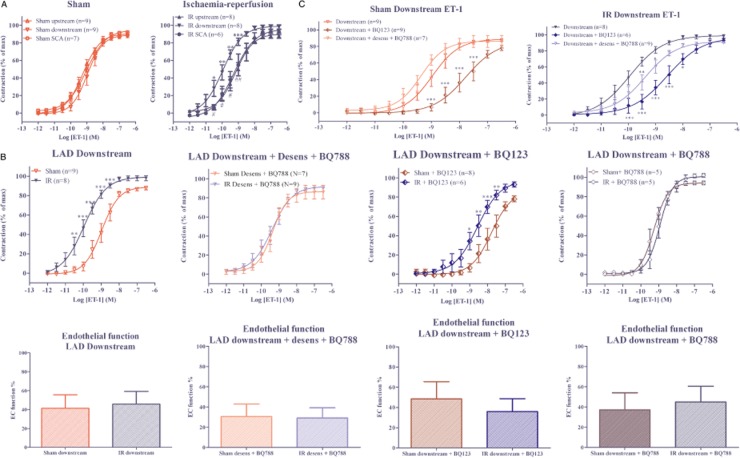Figure 3.
(A) Concentration–response curves of increasing concentrations of ET-1 in LAD upstream to ligature, LAD downstream to ligature, and SCA after IR or sham procedures. The results are shown as mean values ± SEM (n = 6–9). ***P < 0.001, **P < 0.01, *P < 0.05; downstream vs. upstream; ##P < 0.01. # P < 0.05 downstream vs. SCA; two-way anova with repeated measurements and Bonferroni multiple comparison test. Characteristics of the arteries used are shown in Table 1. (B) Concentration–response curves in LAD downstream segments after IR or sham procedures induced by ET-1, ET-1 after S6c induced ETB desensitization and addition of the selective endothelin ETB receptor antagonist BQ788 (30 nM), ET-1 after addition of the selective endothelin ETA receptor antagonist BQ123 (10 μM) and ET-1 after addition of the selective endothelin ETB receptor antagonist BQ788. The results are shown as mean values ± SEM (n = 5–9). ***P < 0.001, **P < 0.01 and *P < 0.05; two-way anova with repeated measurements and Bonferroni multiple comparison test. Characteristics of the arteries used are shown in Table 1. Lower panel: Percentage of endothelium mediated relaxation induced by carbachol (10 μM) after precontraction with PGF2α (10 μM) in LAD upstream to occlusion, LAD downstream to occlusion and SCA after sham operation, IR or PI. (C) Concentration–response curves of increasing concentrations of ET-1 in LAD downstream to ligature, ET-1 after S6c induced ETB desensitization and addition of the selective endothelin ETB receptor antagonist BQ788 (30nM) and ET-1 after addition of the selective endothelin ETA receptor antagonist BQ123 (10 μM) after IR or sham procedures. The results are shown as mean values ± SEM (n = 6-9). ***P < 0.001 and *P < 0.05; compared with ET-1 curve without antagonists; two-way anova with repeated measurements and Bonferroni multiple comparison test.

